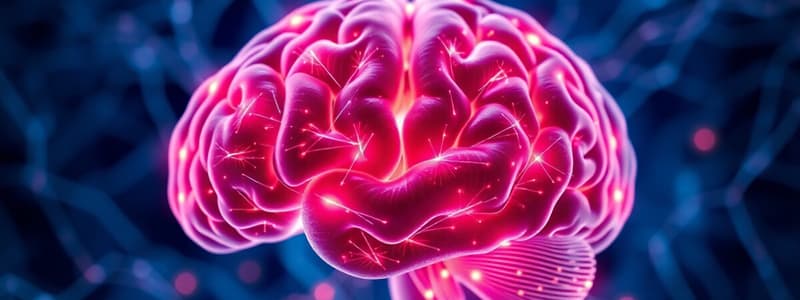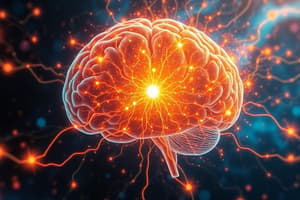Podcast
Questions and Answers
What is the primary function of the brain?
What is the primary function of the brain?
- Housing sensory organs
- Facilitating cognitive activities (correct)
- Regulating hormonal levels
- Controlling muscle movements
What is the approximate number of neurons in the brain?
What is the approximate number of neurons in the brain?
- 50 billion
- 200 billion
- 10 billion
- 100 billion (correct)
Which lobe of the brain is primarily responsible for visual perception?
Which lobe of the brain is primarily responsible for visual perception?
- Parietal lobe
- Frontal lobe
- Temporal lobe
- Occipital lobe (correct)
Which functions are primarily associated with the parietal lobe?
Which functions are primarily associated with the parietal lobe?
What is the main component of the central nervous system?
What is the main component of the central nervous system?
At what stage of life is brain plasticity most pronounced?
At what stage of life is brain plasticity most pronounced?
Which structure of the brain is involved in controlling movement and personal traits?
Which structure of the brain is involved in controlling movement and personal traits?
Which lobes are primarily associated with language centers?
Which lobes are primarily associated with language centers?
What process facilitates the transfer of information from short-term memory to long-term memory?
What process facilitates the transfer of information from short-term memory to long-term memory?
Which characteristic is NOT associated with long-term memory?
Which characteristic is NOT associated with long-term memory?
What are the three memory systems outlined in the HIP model?
What are the three memory systems outlined in the HIP model?
Which form of memory involves recalling specific events and life experiences?
Which form of memory involves recalling specific events and life experiences?
What distinguishes declarative memory from procedural memory?
What distinguishes declarative memory from procedural memory?
Which type of memory refers to skills and tasks that become routine over time?
Which type of memory refers to skills and tasks that become routine over time?
What is the primary focus of neuroscience in relation to memory?
What is the primary focus of neuroscience in relation to memory?
How do psychology and neuroscience view the relationship between mind and brain?
How do psychology and neuroscience view the relationship between mind and brain?
Which paradigm allows for understanding the mind as an emergent property of an individual system?
Which paradigm allows for understanding the mind as an emergent property of an individual system?
What role does the environment play in brain development according to the content?
What role does the environment play in brain development according to the content?
What characterizes a critical period in development?
What characterizes a critical period in development?
What consequence might result from a lack of stimulation during a critical period?
What consequence might result from a lack of stimulation during a critical period?
Which finding is associated with René Spitz's studies?
Which finding is associated with René Spitz's studies?
How did past beliefs about brain plasticity differ from current understanding?
How did past beliefs about brain plasticity differ from current understanding?
What do recent studies reveal about adult brain plasticity?
What do recent studies reveal about adult brain plasticity?
What is the concept of perception based on?
What is the concept of perception based on?
According to the Gestalt theory, how is perception organized?
According to the Gestalt theory, how is perception organized?
What do the principles of Gestalt explain?
What do the principles of Gestalt explain?
What conclusion did Hirst and Kalmar draw about divided attention during their studies?
What conclusion did Hirst and Kalmar draw about divided attention during their studies?
In the functionalist perspective, how does personality relate to perception?
In the functionalist perspective, how does personality relate to perception?
What is the view of the cognitive perspective on perception?
What is the view of the cognitive perspective on perception?
How does attention distribution change when tasks involve different skills?
How does attention distribution change when tasks involve different skills?
Which task receives the most cognitive resources in a dual-task scenario?
Which task receives the most cognitive resources in a dual-task scenario?
What does attention act as in cognitive processes?
What does attention act as in cognitive processes?
What is the role of attention in contemporary cognitive models?
What is the role of attention in contemporary cognitive models?
What distinguishes selective attention from divided attention?
What distinguishes selective attention from divided attention?
What is the metaphor used to describe attention in cognitive psychology?
What is the metaphor used to describe attention in cognitive psychology?
What does Tim Shallice's attentional model suggest?
What does Tim Shallice's attentional model suggest?
What role does experience play in perception, according to Bruner?
What role does experience play in perception, according to Bruner?
How were consciousness processes studied in the late 19th and early 20th centuries?
How were consciousness processes studied in the late 19th and early 20th centuries?
What was the main criticism of the introspective method by behaviorists?
What was the main criticism of the introspective method by behaviorists?
What phenomenon helped reignite interest in the study of consciousness in the 1960s?
What phenomenon helped reignite interest in the study of consciousness in the 1960s?
According to Freud, how are repressed memories processed?
According to Freud, how are repressed memories processed?
How do contemporary models conceive of consciousness?
How do contemporary models conceive of consciousness?
Which phase does the sensory register (RS) represent in the HIP model?
Which phase does the sensory register (RS) represent in the HIP model?
What defines the function of short-term memory (STM) in the HIP model?
What defines the function of short-term memory (STM) in the HIP model?
What does Freud's iceberg analogy represent concerning consciousness?
What does Freud's iceberg analogy represent concerning consciousness?
Which concept is central to the multi-component model of memory?
Which concept is central to the multi-component model of memory?
What is the primary focus of the HIP (Human Information Processing) model on memory?
What is the primary focus of the HIP (Human Information Processing) model on memory?
Flashcards are hidden until you start studying
Study Notes
The Brain and its Function
- The brain is the primary organ for cognitive activity, and the most complex biological organization known.
- All mental processes rely on its functions.
Composed of Neurons
- The brain is composed of approximately 100 billion nerve cells, called neurons, which communicate with each other by forming 1,000 – 10,000 connections (synapses).
Synapses in the Cerebral Cortex
- There are at least 100,000 billion synapses in the cerebral cortex, constantly active.
Function of the Cerebral Cortex
- The cerebral cortex has various functions, including:
- Motor control
- Language production
- Attention
- Thought processing
Structure of the Central Nervous System
- The central nervous system (CNS) is symmetrical and composed of the brain and spinal cord.
Brain Divisions
- The brain is divided into cortical and subcortical structures.
- The cerebral cortex is divided into four lobes:
- Frontal
- Parietal
- Occipital
- Temporal
Functions of the Frontal Lobe
- The frontal lobe regulates action processing, movement control, and personality-influencing traits.
Functions of the Parietal Lobe
- The parietal lobe is responsible for somatic sensations, body image, and spatial localization.
Function of the Occipital Lobe
- The occipital lobe houses visual perception.
Functions of the Temporal Lobe
- The temporal lobe is tied to auditory functions, learning, memory, language, and emotions.
Language Centers
- Language centers are generally located in the temporal and frontal lobes, in the left hemisphere.
Plasticity in the Central Nervous System
- Plasticity in the CNS is the brain’s ability to modify its structures in response to external sensory stimulation, functionally adapting to the environment.
Critical Period
- The critical period is a phase of particular sensitivity of the CNS to external influences, characterized by the progressive tuning between the brain and the external world.
Importance of the Critical Period
- The absence of stimulation during the critical period can cause irreversible damage to development because many skills are acquired in this phase, and are not determined solely by genetic factors.
Environmental Effects
- The environment activates a series of genes that would remain latent in the absence of stimuli.
Brain Plasticity in Adulthood
- Research has shown that, despite some reduction, there are areas of plasticity even in the adult brain, allowing for continued learning.
Maintaining Brain Plasticity
- The brain remains plastic and sensitive to external input. However, inactive neural circuits tend to lose their efficiency and functionality over time. Targeted brain exercises can help maintain plasticity.
Perception
- Perception is a cognitive process that allows us to obtain information from the external world by integrating sensations collected by the sense organs with past experiences.
Schools of Thought on Perception
- Perception has been studied by major psychological schools, including:
- Psychophysiological perspective
- Gestalt theory
- Functionalist approach
- Cognitive perspective
Attention
- Attention is the cognitive ability to focus on relevant information and inhibit irrelevant information. It functions like a filter that selects incoming information based on interests and expectations.
Forms of Attention
- The two main forms are selective attention, which focuses on one task at a time, and divided attention, which allows multiple tasks to be performed concurrently.
Attention as a Control System
- In more recent models, attention is seen as a control system for cognitive operations, not just a filter. It intervenes in the selection between conflicting cognitive processes.
Consciousness
- In contemporary models, consciousness is seen as an attentional control system for mental operations, involving the functioning of the prefrontal lobes.
Memory
- The multi-component model suggests that memory does not store stimuli in a single trace but maintains different components, such as temporal, spatial, or frequency.
Memory Systems
- The HIP (Human Information Processing) model views memory as an active mental function where information is acquired, processed, coded, and then stored, similar to how a computer works.
Memory Types
- The two main forms of memory are episodic memory, which relates to specific events and life experiences, and semantic memory, which is a long-term storage for facts, concepts, and abstract knowledge about the world.
Neuroscience and Memory
- Neuroscience studies the nervous system, including the structure and function of the brain to analyze how it stores and retrieves information, investigates the neural circuits in perception, memory, and language, and analyzes how synapses enable the transfer of information.
Relationship Between Mind and Brain
- Neuroscience views the mind as a product of the evolution and organization of brain structures, closely linked to environmental stimuli. Psychology analyzes mental processes and human behavior, creating a dialogue between mind and body.
The Paradigm of Complexity
- This paradigm allows us to see the mind as an emergent property of the system-individual, not reducible solely to physical components. It considers the interaction between brain structure and external cultural influences.
Studying That Suits You
Use AI to generate personalized quizzes and flashcards to suit your learning preferences.




